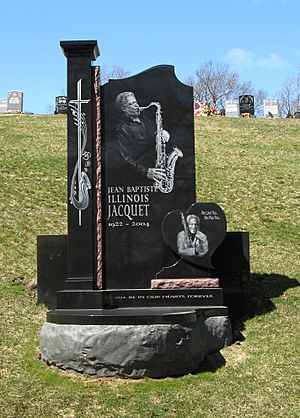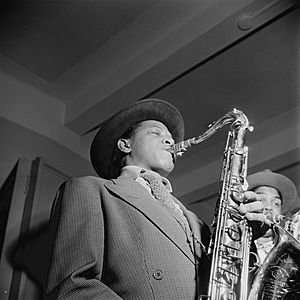Illinois Jacquet facts for kids
Quick facts for kids
Illinois Jacquet
|
|
|---|---|

Jacquet, New York City, c. May 1947 (Photograph by William Paul Gottlieb)
|
|
| Background information | |
| Birth name | Jean-Baptiste Illinois Jacquet |
| Born | October 30, 1922 Broussard, Louisiana, US |
| Died | July 22, 2004 (aged 81) New York City, New York, US |
| Genres | Swing, bebop, jump blues |
| Occupation(s) | Musician, bandleader, composer |
| Instruments | Tenor saxophone, bassoon, alto saxophone |
| Years active | 1941–2004 |
| Labels | Apollo, Savoy, Aladdin, RCA, Verve, Mercury, Roulette, Epic, Argo, Prestige, Black Lion, Black & Blue, Atlantic |
| Associated acts | Cab Calloway, Dexter Gordon, Flip Phillips |
Jean-Baptiste "Illinois" Jacquet (born October 30, 1922 – died July 22, 2004) was an American jazz musician. He was famous for playing the tenor saxophone. Many people remember his amazing solo on the song "Flying Home". This solo is known as one of the first important saxophone solos in R&B music.
Illinois Jacquet was a pioneer of a special saxophone sound. This sound became a big part of jazz and early rock and roll. He was also a very skilled musician. He could play beautiful melodies on fast songs and slow songs. Jacquet also played the bassoon, which is rare for a jazz musician.
Contents
Early Life and Musical Beginnings
Growing Up in a Musical Family
Illinois Jacquet's parents were Marguerite Trahan and Gilbert Jacquet. They were Creoles of color. When he was a baby, his family moved from Louisiana to Houston, Texas. He grew up there with his five brothers and sisters. His father was a bandleader part-time, meaning he led a music group.
Illinois started playing music in his father's band when he was a child. He mostly played the alto saxophone. His older brother, Russell Jacquet, played the trumpet. His other brother, Linton, played the drums. Music was a big part of their family life.
Joining Bands and Switching Instruments
When Illinois was 15, he started playing with the Milton Larkin Orchestra. This was a popular dance band in the Houston area. In 1939, he moved to Los Angeles, California. There, he met the famous musician Nat King Cole. Jacquet sometimes played with Cole's music group.
In 1940, Nat King Cole introduced Jacquet to Lionel Hampton. Hampton was forming a new big band. He wanted Jacquet to join, but he asked him to switch to the tenor saxophone. This was a big change for young Illinois.
A Career in Jazz Music
The Famous "Flying Home" Solo
In 1942, when Jacquet was just 19, he played a solo on the Lionel Hampton Orchestra's song "Flying Home". This was one of the first times people heard the "honking" sound of a tenor saxophone on a record. The song became a huge hit!
"Flying Home" quickly became the most exciting part of their live shows. Jacquet had to play this amazing solo every night. Other saxophone players who joined the band later, like Arnett Cobb and Dexter Gordon, also played this solo. It's one of the few jazz solos that many musicians learned and played almost exactly the same way.
Moving to Other Big Bands
Jacquet left Hampton's band in 1943. He then joined Cab Calloway's Orchestra. He even appeared with Calloway's band in the movie Stormy Weather (1943), which starred Lena Horne.
In 1944, Illinois Jacquet went back to California. He started a small band with his brother Russell and a young musician named Charles Mingus. During this time, he was in an Academy Award-nominated short film called Jammin' the Blues. He also played at the very first Jazz at the Philharmonic concert.
Leading His Own Band and Later Years
In 1946, Jacquet moved to New York City. He joined the Count Basie orchestra, taking the place of Lester Young. Later, in 1981, he started leading his own group, the Illinois Jacquet Big Band. He led this band until he passed away.
Jacquet made history in 1983. He became the first jazz musician to be an artist-in-residence at Harvard University. This meant he taught and performed there. In 1993, he even played "C-Jam Blues" with President Bill Clinton at Clinton's inaugural ball at the White House. Illinois Jacquet's last performance was on July 16, 2004, in New York.
Personal Life and Legacy
Family and Passing
Illinois Jacquet was married to Jacqueline Jacquet. He also had a daughter named Pamela Jacquet Davis.

Jacquet passed away at his home in Queens, New York, on July 22, 2004. He was 81 years old. He is buried in Woodlawn Cemetery in The Bronx, New York City.
His Impact on Music
Illinois Jacquet's saxophone solos from the 1940s had a big impact. They influenced the style of saxophone playing in rhythm and blues and rock and roll. His unique "honking" and "screeching" sounds used both the low and high notes of the tenor saxophone. Even though his style seemed raw, it was very skilled. His influence can still be heard in jazz music today.
Fighting for Fairness
Challenging Segregation in Houston
Illinois Jacquet was also a brave activist. He spoke out against Jim Crow laws in Houston. These laws forced Black people and white people to be separate. Jacquet booked his band to play at the Rice Hotel. But the hotel said that African American musicians had to enter through a back alley door.
Jacquet refused to accept this rule. He told the hotel that if his all-Black orchestra couldn't use the main entrance, he would cancel the show. The Rice Hotel agreed to let his band use the main entrance. This was a big step in fighting unfair rules.
A Concert for Equality
Jacquet felt strongly about ending segregation in his hometown. He wanted Houston to have a great concert where everyone could enjoy the music together.
Jazz producer Norman Granz, who also believed in fairness, helped Jacquet. They planned a special concert at Houston's Music Hall on October 5, 1955. Famous musicians like Ella Fitzgerald, Dizzy Gillespie, Oscar Peterson, and Buddy Rich played with Jacquet.
Granz and Jacquet worked together to make sure there was no segregation at the event. They didn't sell tickets in advance. Granz removed all the "white" and "black" signs that showed separate areas in the venue. He even hired off-duty police officers for security.
The band played for an audience that was not separated by race. However, there was still some trouble. Five police officers came into Ella Fitzgerald's dressing room. Jacquet and Gillespie were playing dice games, which the police used as an excuse to arrest them, Ella Fitzgerald, and her assistant. They were taken to the police station, where photographers were waiting. After paying their fines, they all returned to the Music Hall and played the second part of the concert. The audience didn't even know what had happened.
Memorials and Recognition
In 2008, a building called The Chapel of the Sisters in Prospect Cemetery was restored. It was renamed the Illinois Jacquet Performance Space. This space is on the grounds of York College in Jamaica, Queens, and is used for performances.
|
See also
 In Spanish: Illinois Jacquet para niños
In Spanish: Illinois Jacquet para niños


